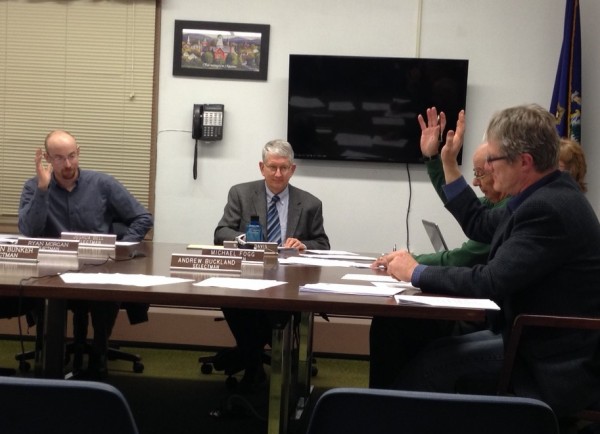
FARMINGTON – Franklin County towns that have relied on Community Development Block Grant funding to help pay for infrastructure upgrades are finding they no longer meet the low- to moderate-income standards for eligibility.
Farmington town officials made the surprising discovery late last week when they were in contact with state’s Department of Economic Community Development, which administers the federal funding, about the intent to apply for a revitalization project grant for Front Street on into West Farmington.
The plan, recommended by the Downtown Tax Increment Financing Advisory Committee at their meeting on Nov. 10, was to use $100,000 from 2015’s TIF revenue as a 25 percent match requirement for $400,000 in CDBG funding in a project totaling $500,000. The plan included new sidewalks the length of Front Street and increased street lighting.
Towns that used to meet the standard 51 percent of low- to moderate-income households in order to qualify for CDBG Downtown Revitalization funding was based on 2010 census data. But that changed recently after the U.S. Department of Housing and Urban Development decided the census results weren’t accurate enough and now base eligibility requirements on the American Community Survey, taken between 2000 and 2005.
As a result, Farmington’s percentage of low- to moderate-income level dropped from 51.9 percent to 41.77 percent, making it ineligible for federal funding.
Industry is the only town in Franklin County that continues to meet the 51 percent threshold for CDBG eligibility at 52.4 percent, as do the unorganized territories, said Farmington Town Manager Richard Davis.
“We’re very disappointed,” Davis told selectmen at their meeting Tuesday night. He noted the town’s planning assistant Cindy Gelinas had been in contact with the DECD prior to the TIF advisory committee meeting about seeking a downtown revitalization grant and wasn’t told of the survey data change until Nov. 13, after the committee had met and made its recommendations.
“This is really news to us,” he said. The committee had considerable discussion for use of TIF revenue before settling on Front Street upgrades that were to continue on into West Farmington as the project’s focus. “Now, it’s not possible,” Davis said.
In her subsequent research, Gelinas did find that the town could conduct its own town-wide survey. A sample size of 400 households out of the 2,852 total is required and if it met the 51 percent threshold, the DECD could use the current survey data and the town could be back in the grant writing business. Another, more drastic alternative is for the town to apply for a “slum and blight” designation, at which the town needs to show-using state and federal standards-that 25 percent of the area within its town limits falls into that category. A public hearing and a town vote would be required to adopt a slum and blight designation.
Davis said conducting a survey “can be difficult to get people to respond,” because household income amounts need to be revealed.
Selectmen approved two other recommendations coming from the TIF committee. One is to send out a request for engineers to bid on the design project upgrades from Front Street to West Farmington. Davis gave a rough estimate of $20,000 to be used from this year’s TIF revenue.
Selectman Joshua Bell, who serves on the TIF committee, noted that continuing to pursue the project upgrades made sense, despite the CDBG funding ineligibility at this point.
“We (the committee) were all in agreement to get the engineering done and have a plan in place,” Bell said. He also argued for the committee’s third recommendation, to get an update on the cost to build a bridge across the Sandy River to connect downtown with West Farmington.
All three selectmen attending the meeting: Bell, Andy Buckland and Michael Fogg, voted to approve the committee’s two recommendations of seeking engineering design bid requests and getting a bridge cost update.
Davis said the committee had set the next meeting for Jan. 7 to discuss the letter of intent for a CDBG grant, but now wondered if another meeting should be scheduled or to “delay action until we know more.”





Why would we jump at taking federal dollars for this work and be so adamantly opposed to programs that actually help people? It’s beyond weird.
Sidewalks on Front Street are a stupid waste of tax dollars. The street could be made plenty safe by doing something to discourage the geniuses that think they are saving time by using it to avoid downtown. I travel the route daily and stay on the main road and almost always see the vehicle in front of me that uses the ‘short cut’ waiting for me to pass while they sit by McDonald’s. Just let it go; we don’t always have to burn tax dollars just because they’re available.
The town needs to build a sidewalk down front street. It’s s big safety .issue.
These other things are only going to make some rich people richer.
So build the damn sidewalk and tell em to fund their own projects.
Well said, Mr. Knight. The voters voted for “fiscally responsible” candidates yet approved every bond issue. That is an oxymoron. How is it different to seek federal dollars for sidewalks yet reject them for healthcare?
Confused -isn’t a drop from 51.9% to 41.77% a good thing? If numbers are correct does this mean people have moved out of low to moderate income to a higher income?
A community able to make improvements without the help of federal gov’t- isn’t this a good thing?
If every community was in a position to enhance its city without the fed money -stay with me -would that or could that lead to lower taxes?
Isn’t akin to being upset to finding out people have moved from needing food stamps to not needing food stamps because they improved their standard of living.